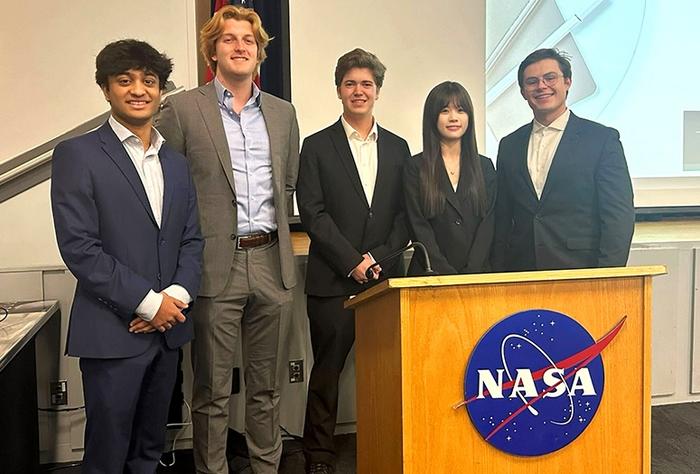In the realm of space exploration, the need for effective physical exercise remains a paramount concern due to the adverse effects of prolonged periods spent in microgravity environments. As astronauts are required to maintain muscle and bone strength during missions, a team of innovative engineering students from Rice University has developed a groundbreaking exercise harness that addresses this critical challenge. This innovative solution, emerging from a collaborative effort supported by NASA’s HumanWorks Lab, underscores the importance of engineering prowess in the pursuit of tackling real-world problems faced in space.
The challenge posed to the students was significant: create a harness that would be comfortable, adaptable, and responsive to the unique demands of exercise in space. Given the long durations of future missions anticipated by NASA, coupled with the extreme conditions astronauts will likely face, traditional exercise harness designs exhibit serious limitations. Many existing harnesses are plagued by issues of discomfort, causing chafing and bruising during usage. Mentored by Vanessa Sanchez, a prominent assistant professor at the George R. Brown School for Engineering and Computing, the team of undergraduate engineers, including Emily Yao, Nikhil Ashri, Jose Noriega, and Ben Bridges, in conjunction with graduate student Jack Kalicak, set out to create a harness that would alleviate these concerns.
Their design incorporated innovative features such as pneumatic padding that could mold to the user’s body, distributing pressure more evenly across the surface. This approach not only aims to enhance the comfort of astronauts during rigorous exercise routines but also provides a mechanism for real-time adaptation to dynamic load shifts. As muscle and bone atrophy becomes a pressing issue in the microgravity environment, the ingenuity behind the team’s design stands to play a critical role in the health and performance of astronauts on extended missions.
Moreover, the team recognized an additional need—one centered on integrating modern technology into the exercise harness. Current devices often lack the sophistication necessary for optimal user experience and monitoring. By incorporating sensors into their harness design, the students were able to enable astronauts to track crucial metrics such as temperature, humidity, and load distribution. This data empowers users to tailor their exercise regimens based on immediate feedback, thus enhancing performance and safety.
As missions become more complex and longer in duration, the requirement for diversity in exercise routines will become increasingly important. With this in mind, the design team also focused on reducing the overall weight of the harness while increasing its versatility through modular attachments. These components allow astronauts to adapt the harness for a wider array of exercises, optimizing muscle engagement and ensuring a balanced load across different muscle groups.
Their efforts culminated in a design that was not only functional but also competitive on a national scale. At the 2025 Technology Collaboration Center’s Wearables Workshop and University Challenge, hosted at NASA’s Johnson Space Center, the Rice team’s adaptive harness won the Best Challenge Response Award, a testament to the effectiveness of their innovative approach. This prestigious recognition attests to the collaborative spirit and engineering talent represented by the Rice University team, which competed against other top-tier institutions.
The culmination of student research and real-world application highlighted by this harness design serves as a powerful reminder that engineering can have a profound impact, extending beyond terrestrial challenges to address the complexities of human life in outer space. The experience gained throughout this project not only provided the students with practical skills in design engineering but also fostered a sense of camaraderie and teamwork that is essential in any collaborative engineering effort.
The culmination of their work reflects a broader vision—a world where astronauts are equipped with cutting-edge technologies that enhance their ability to maintain health and fitness, thereby ensuring successful missions. The work of these undergraduate engineers is a microcosm of the potential that lies in academic institutions and their collaborations with major space entities. This partnership not only nurtures innovation but also provides invaluable opportunities for students to face real-world challenges directly.
With projects like this one receiving support from notable entities such as the National Science Foundation, the work extends beyond academic endeavors. It encapsulates a proactive approach to ensuring astronaut well-being, thus underscoring the need for continuous investment in research that seeks to enhance the human experience in the cosmos. As future missions to Mars and other distant destinations loom on the horizon, the role of exercise in counteracting the debilitating effects of microgravity remains an area worthy of attention and investment.
The adaptive exercise harness represents a leap forward in addressing these challenges. Its integration of technology, comfort-focused design, and adaptability showcases how student-led initiatives can create meaningful solutions that resonate within the highest echelons of space exploration. The team’s hard work and dedication reflect a commitment to not only push the boundaries of engineering but also to ensure that as humanity ventures further into space, the health and safety of astronauts are prioritized.
Through this innovative harness, a new standard for exercise equipment in space may well have been set, fundamentally changing how astronauts prepare for and recover from the physical demands of their missions. As they shift from Earth to the cosmos, this pioneering design may just prove pivotal in the quest to unlock the challenges of exercising in space.
Subject of Research: Development of innovative exercise harness for astronauts.
Article Title: Rice University Engineering Students Design Groundbreaking Exercise Harness for Astronauts.
News Publication Date: October 2023.
Web References: Rice University Engineering
References: National Science Foundation, NASA HumanWorks Lab.
Image Credits: Rice University.
Keywords
Space Innovation, Exercise Harness, Astronaut Health, Rice University, NASA Collaboration, Engineering Design, Technology Integration, Microgravity, Student Research.




